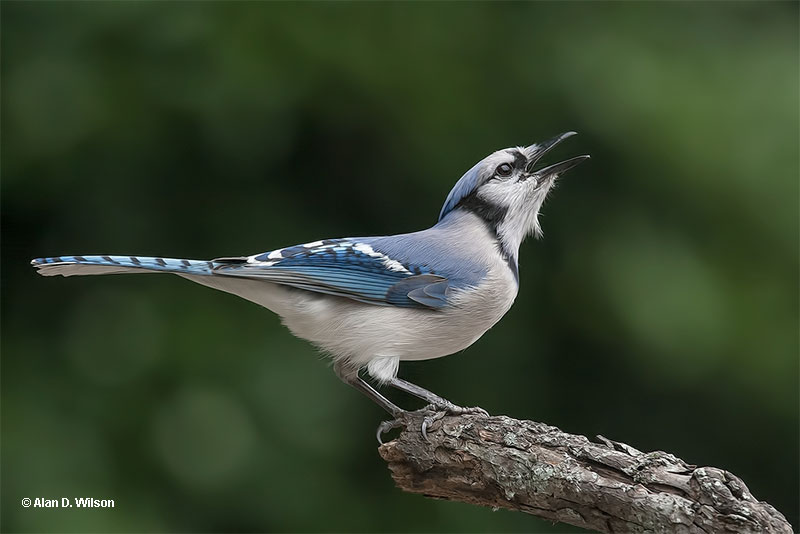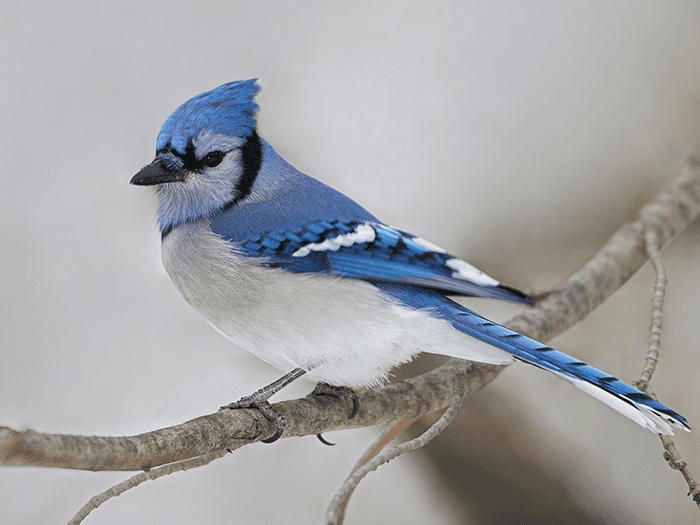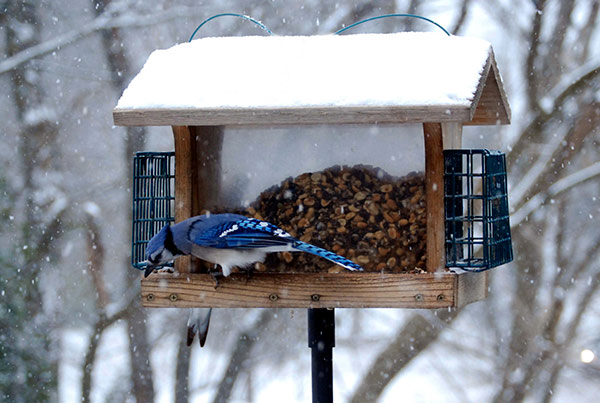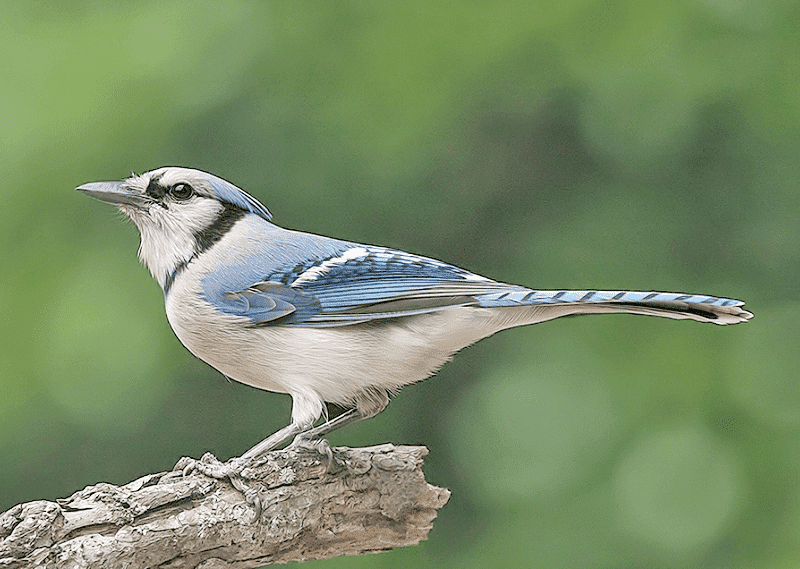
Blue Jays symbolize a lot of things, but the main things they represent are strength, confidence, and communication.
Blue Jays are a great animal to pull inspiration from. These gorgeous birds have a very strong spirit and symbolize many important things. Most know them for their mimicry skills, intelligence, and of course, their gorgeous blue plumage. However, they have much more profound importance.
Seeing Blue Jays a lot can indicate a message waiting for you. Here’s what you need to know about Blue Jay symbolism and what to do when Blue Jays show themselves to you.
On this page
Blue Jay Meaning & Symbolism
Blue Jays have different meanings depending on who’s observing them. It could be determination, protection, selflessness, honesty, and healing. Native American Culture, Christianity, and Wicca all have different meanings and symbolism regarding Blue Jays.

Blue Jay
In Native American culture, Blue Jays are seen as representatives of change. If Blue Jays are seen after sunset or before dawn, it signals that change is coming and encourages people to get ready for the change that is coming.
Blue Jays primarily symbolize protection, divinity, selflessness, honesty, and kindness in Christianity. It also has a long history of being considered an omen of good fortune.
In Wicca, Blue Jays represent various ideas like creation, abundance, and healing. Alternatively, those who practice Wicca also see them as an omen of luck and fortune.
What does it mean when you see a Blue Jay?
The Blue Jay is a North American bird seen almost everywhere. It’s one of the first bird species to arrive when winter subsides from the northern United States and Canada. They’re welcome visitors because they eat annoying insects like flies and mosquitoes.
Blue Jays are often seen as signs of good luck. If you see one while you’re out or one visits your feeders, it could be a sign that you or someone close to you have good things coming.
Blue Jays can be encountered anywhere, but you’re more likely to experience them if their nesting site is nearby.
They can be encountered at any time of year, but it’s important to note that Blue Jay symbolism is not set in stone, it can be something more ominous, or it could just be that the Jays are curious.

Blue Jay Spiritual Meaning
Blue Jays are exceptional animals when it comes to spiritual meaning. These birds are intelligent, funny, and have a color that communicates important messages to those who know how to interpret them. As a result, Blue Jays often appear in people’s lives when they’re ready for new beginnings or even a new adventure.
Blue Jays are said to show up to help you find your way out of the dark and into the light. Along with their intelligence, they’re also known for their courage, determination, and resilience.
Some people call these birds “the bluebird of happiness” because of all the good things they symbolize. Some even go as far as to claim that Blue Jays are here on Earth to teach us how to live freely in an abundant and peaceful world and protect us from harm.
Related: What does seeing a blue-colored bird mean?
It is also believed that these birds are messengers of harmony and peace sent by our Creator to remind us to live in harmony with nature and how beautiful life can be.
As you can see, Blue Jays have a wide variety of meanings. However, there’s some commonality in these meanings. All of them represent good things. They represent growth and good nature, so you don’t need to feel worried if you see one.
Just know they’re trying to share something spiritually with you, so be receptive and keep an open mind!
Independence and Freedom
Like most birds, Blue Jays symbolize independence and freedom. This is because most people associate flight and wings with freedom, independence, escape, joy, and more.
Freedom and independence are things humanity has strived for and continues to strive for. It influences our actions, way of life, and decisions.

Photograph © Alan Wilson.
Blue Jays take this to the next level; they are not only birds but also very confident and independent beings, which helps them get this message across.
They can leave and fly away when things are scary and uncomfortable. If you see Blue Jays more often than usual, they may be trying to tell you that it’s time to “take flight” and regain your independence and freedom.
This could be from someone in your life or your job. They may also encourage you to take a leap and facilitate communication or step out of your comfort zone.
New Beginnings and Adventures
Another spiritual significance of Blue Jays is new beginnings and adventures. They tend to show up in people’s lives when said people are ready for this kind of change.
Blue Jays are great representatives of this because they’re one of the first birds to show up when spring arrives, which is usually associated with a new beginning.
They’re confident little birds that we can all learn a lesson from. They don’t let anything stop them and welcome change. They’re not scared to explore new surroundings.
Blue Jay Tattoo Meaning
As we alreadylearned, Blue Jays are very friendly and clever animals which make them great subjects for tattoos. Blue Jay tattoos have become increasingly popular and for a good reason! People love what Blue Jays symbolize and they also love the vibrant color of the birds.
When it comes to what a Blue Jay tattoo represents, it’s personal to the person who has it because there are quite a few different meanings.
Read more: Bird Tattoo Meanings & Ideas
Not many people know that Blue Jays are intelligent and social animals. Below you’ll find a list of Blue Jay tattoo meanings but a big one is family.
Blue Jays are highly protective of their families, so much so that they’re often used to symbolize family and protection. These birds also show great creativity and determination when it comes to protecting their nests.
Here is everything Blue Jay tattoos can mean:
- Family
- Protection
- Intelligence
- Truth
- Clarity
- Faithfulness
- Fearlessness
- Adaptability
- Determination
- Communication
Frequently Asked Questions
Is a Blue Jay a good omen?
Yes, Blue Jays are good omens. They represent good things like hope, truth, protection, family, and many other things.
What does it mean when you dream about a Blue Jay?
When you dream of Blue Jays, it usually means you must listen to your instincts and keep and eye on your surroundings. A significant change may come to your life that they don’t want you to miss, or they may be trying to tell you that someone close to you is trying to deceive you.
What is the meaning of a Blue Jay feather?
If you find a Blue Jay feather, you’ll soon be blessed with motivation, intelligence, courage, and energy so you can achieve your goals.
What does it mean when you see two Blue Jays?
To some, seeing two Blue Jays means that your prayers will be answered. Others believe that seeing two blue jays implies that you are about to start a new spiritual journey. Whatever you believe, it’s safe to say that personal transformation and growth are coming, and if you’re going through a difficult time, better days are coming.
Conclusions
Blue Jays are incredible birds that mean a lot of different things. However, you’ll be happy to know that seeing Blue Jays means all good things.
First, however, be sure that you’re paying attention to the birds’ behavior and how often you see them.
Since they represent so many things, you’ll have to pinpoint what the Blue Jays are trying to tell you precisely.


K a h n e
Monday 25th of December 2023
I know they hate my cat! They also have a relative the gray Jay. They are awful to my cat! A gorgeous bird, enjoyed the article.
Patrick O'Donnell
Tuesday 26th of December 2023
@Kahne- Glad you enjoyed the article! Yes, if Blue Jays seen an animal they think might be a threat, they are pretty quick to harass it. When that happens, sometimes, all we can do is bring our pets inside.
Andree Valeton
Thursday 28th of September 2023
My family had a blue jay kind of "hangout" with us all afternoon last Sunday. Appeared on the back porch and after a while was eating crackers out of our hands! The bird drank from a bowl of water we gave him and eventually even participated in eating one of the chicken wings we were cooking. (stood on the wing and "pecked" the chicken off.) This went on for about (3) hours. We moved to the front yard and sat on the bed of a truck while the kids rode bikes in the street. Believe it or not, the blue jay came in the front yard and SAT ON THE TRUCK WITH US! It was so unbelievable. If you could give me some insight, I would greatly appreciate it. It actually seemed as if it were someones pet?
Patrick O'Donnell
Thursday 28th of September 2023
@Andree- Wow, what a day that must have been! You are right to wonder if it might have been someone's pet. Wild Blue Jays are pretty smart but they don't normally get that close. It's impossible to say why that jay acted so confiding but I would guess that someone took care of and fed it when it was young. Let us know if it comes back for more snacks!